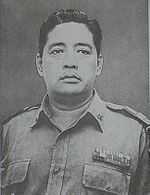Soeprapto (general)

Lieutenant General R. Soeprapto (24 August 1920 – 1 October 1965) was the second deputy commander of the Indonesian Army, and was kidnapped from his home in Jakarta by members of the 30 September Movement in the early hours of October 1. He was later killed at Lubang Buaya.
Early life
Soeprapto was born in Purwokerto, Central Java. He graduated from high school in 1941, then continued his education at the Dutch royal military academy in Bandung, but did not graduate as the Japanese invaded. Soeprapto was detained by the Japanese, but managed to escape. Once Soeprapto realized he was not on the wanted list of the Japanese Kempeitai military police, he signed up for military training. When this finished, he worked at the public education office.[1]
Military career
Following the Independence, Soeprapto joined the People's Security Army (TKR), the forerunner of the Indonesian Military. He was involved in the disarming of the recently surrendered Japanese. He was later appointed adjutant to Indonesia's first military commander, General Sudirman, a post he held from 1946-1947.[2] In September 1949, he became chief of staff of the Diponegoro Division of Central Java, then moved to Army Staff HQ Jakarta in 1951.On May 7, 1960 he was transferred to Medan, Sumatra and appointed deputy Army chief of staff for Sumatra. His final post was as second deputy Army chief of staff, which he held from July 1 1962 until his death.
Death
In the early hours of the morning of 1 October 1965, Soeprapto was not able to sleep due to a toothache, and instead was painting a picture he was working on. Members of the 30 September Movement arrived at Soeprapto's house at Jalan Besuki No. 9, in Jakarta's Menteng district. The kidnappers, from the Tjakrabirawa presidential guard, told Soeprapto he was being summoned to appear before President Sukarno. He asked for permission to change his clothes, but was refused, and Soepraptio was taken by truck to Lubang Buaya, the movement's base on the southern outskirts of Jakarta.[3] His wife was awakened by the family's dogs barking and came into the living room but was forced back by her husband's captors. She was forbidden to use the phone, and rushed to it when the soldiers left but it had been cut. She scribbled a note to send to the Parman's place to raise the alarm, but she did not know that General Parman had also been seized that morning.[4]
Later that night, he was shot to death along with other members of the Army general staff who had survived their kidnapping attempts. All the bodies were thrown into an unused well. The bodies were recovered and all were given a state funeral on October 5, before being buried at the Heroes Cemetery, Kalibata. On the same day, via Presidential Decision No. 111/KOTI/1965, President Sukarno formerly made Soeprapto a Hero of the Revolution.[5]
References
General
- Bachtiar, Harsja W. (1988), Siapa Dia?: Perwira Tinggi Tentara Nasional Indonesia Angkatan Darat (Who's Who?: Senior Officers of the Indonesian Army), Penerbit Djambatan, Jakarta, ISBN 979-428-100-X
- Mutiara Sumber Widya (publisher) (1999) Album Pahlawan Bangsa (Albam of National Heroes), Jakarta
- Sekretariat Negara Republik Indonesia (1994) Gerakan 30 September Pemberontakan Partai Komunis Indonesia: Latar Belakang, Aksi dan Penumpasannya (The 30 September Movement/Communist Party of Indonesia: Background, Actions and its Annihilation) ISBN 9790830025
- Sudarmanto, Y.B. (1996) Jejak-Jejak Pahlawan dari Sultan Agung hingga Syekh Yusuf (The Footsteps of Heroes from Sultan Agung to Syekh Yusuf), Penerbit Grasindo, Jakarta ISBN 979-553-111-5